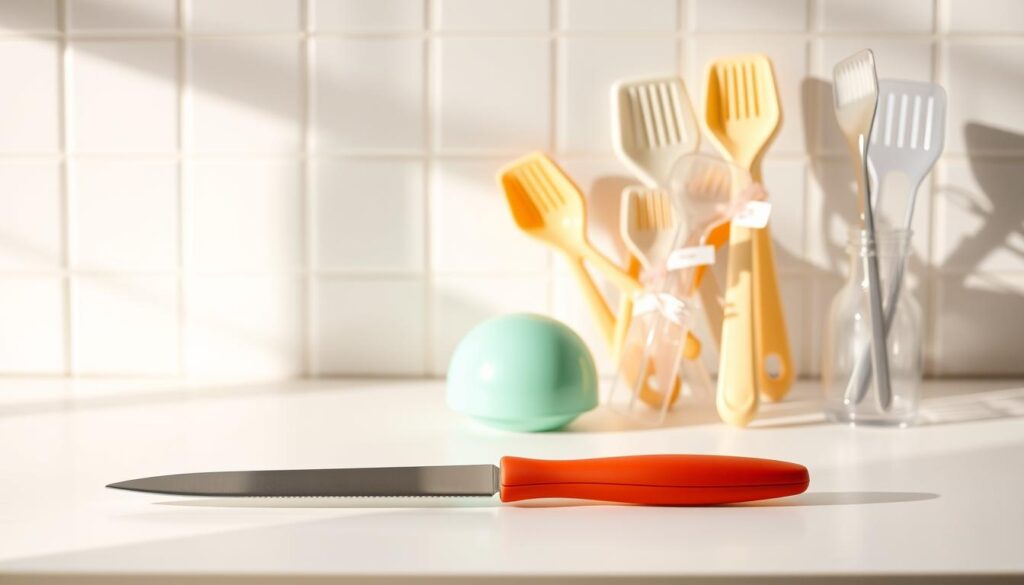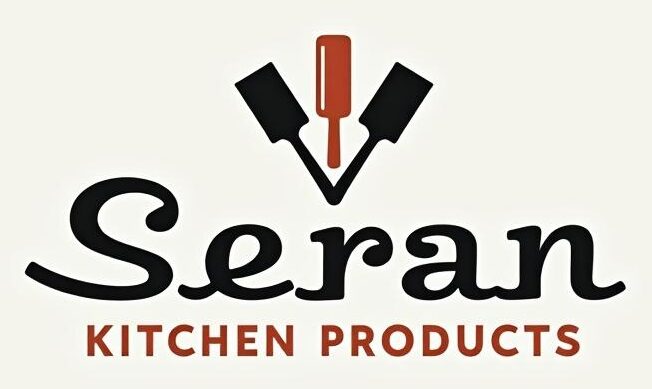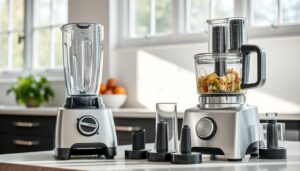As the aroma of freshly baked cookies fills your kitchen, laughter echoes during family dinners. The tools we use often get overlooked. But, have you ever thought about what’s under your trusty spatula or mixing spoon?
The debate of Silicone vs Plastic Kitchen Tools is more than just about convenience. It’s about picking the best material for our health and cooking adventures. Every stir and flip matters, as it affects our kitchen and family’s well-being.
Key Takeaways
- Understanding the materials in your kitchen tools is vital for safety.
- Silicone kitchen tools offer excellent heat resistance and flexibility.
- Plastic kitchen tools are often lightweight but can have safety concerns.
- Choosing the best kitchen tool material can impact your health.
- Both silicone and plastic have unique pros and cons that need consideration.
Introduction to Kitchen Tool Materials
Choosing the right cooking tools starts with knowing the different materials. You’ll find options like silicone, plastic, stainless steel, and wood. Each has its own benefits and fits different cooking needs.
Silicone is flexible and can handle high heat. It’s great for baking mats and spatulas because food doesn’t stick. Plastic tools are light and cheap, and many are now BPA-free for safety.
Stainless steel is tough and lasts a long time. It’s perfect for utensils and cookware. Wood is less common but adds a rustic touch and is gentle on cookware.
When comparing kitchen tools, food safety is key. Choose food-grade silicone and BPA-free plastic for health. Knowing this helps ensure your tools are safe and work well.
The Rise of Silicone Kitchen Tools
In recent years, silicone kitchen utensils and gadgets have become very popular. Home cooks and professional chefs are choosing them for their benefits. Silicone can handle high heat without melting or changing shape.
One of the best things about silicone is how flexible it is. It can bend and fold easily, perfect for mixing, scraping, and serving. Plus, it’s good for the environment because it’s made from natural resources and can be reused.
Another great thing is how easy silicone is to clean. Many silicone gadgets are dishwasher safe, saving time and effort. People love the vibrant colors and designs too. It’s clear why more people prefer silicone over plastic kitchen tools.
Understanding Plastic Kitchen Tools
Plastic kitchen tools are common in many homes because they are versatile and affordable. They are light and easy to use, perfect for daily cooking. Many like them because they are cheap, great for starting a kitchen.
It’s important to choose plastic tools made from safe materials. This means they won’t harm your food or health. Look for products labeled as BPA-free to avoid health risks.
Some plastic tools may not last long, getting damaged by heat or strong cleaners. But, many people stick with them because they are handy and easy to use. They find plastic tools very useful in the kitchen.
Silicone vs Plastic Kitchen Tools: What’s Safer & More Durable?

Choosing kitchen tools means looking at safety first. It’s important to know if silicone or plastic is safer and more durable.
Safety Considerations for Silicone
Silicone kitchen tools are safe and last long. They’re made from food-grade silicone. This material doesn’t release harmful chemicals into food, even when it’s hot.
The safety of silicone kitchen tools makes them great for health-conscious cooks. Unlike some plastics, silicone is free from toxins. It also stands up to heat well, making it good for many cooking methods.
Safety Considerations for Plastic
Plastic kitchen tools have their own safety worries. Many plastics have Bisphenol A (BPA) and phthalates, which can be harmful. It’s key to choose BPA-free plastic to avoid these risks.
Not all plastic can handle high heat. This can cause it to release harmful substances. So, it’s important to check the materials of plastic kitchen tools carefully.
Durability of Silicone vs Plastic Kitchen Tools
When choosing kitchen tools, it’s key to look at their durability. Silicone and plastic have different qualities. Silicone utensils last long because they handle high temperatures well, don’t stain easily, and keep their shape.
With proper care, silicone items can last for years. This makes them a top pick for those wanting durable kitchen tools.
Longevity of Silicone Kitchen Utensils
Silicone is very durable, making it last longer in kitchens. It can handle heat without warping or losing shape. Plus, it doesn’t hold onto smells or tastes from food.
This makes silicone tools a smart choice. They last longer than plastic ones, saving you money in the long run.
Wear and Tear of Plastic Kitchen Utensils
Plastic kitchen tools have a different story. They’re light and cheap, but they wear out fast. Using them a lot can cause them to warp, scratch, and change color.
This shortens their life and raises safety concerns. Plastic tools can lose their shape and affect food safety and cooking quality.
Benefits of Using Silicone Kitchen Tools
Silicone kitchen tools bring many advantages to cooking and baking. They have a non-stick surface, making food easy to remove. This means you don’t need to use a lot of oil or spray, making cooking more efficient.
Silicone tools are also flexible. They can bend and flex, perfect for scraping bowls and mixing ingredients. This flexibility helps ensure you get every last bit of batter or sauce, reducing waste.
Another great thing about silicone tools is they can handle extreme temperatures. They are safe for ovens, microwaves, and dishwashers. This makes them some of the best kitchen tools on the market.
To show the benefits, here’s a table comparing silicone tools to traditional ones:
| Feature | Silicone Kitchen Tools | Traditional Kitchen Tools |
|---|---|---|
| Non-stick | Yes | Varies |
| Flexibility | High | Low |
| Temperature Resistance | -40°F to 450°F | Varies by material |
| Dishwasher Safe | Yes | Depends on material |
Silicone kitchen tools make cooking and baking easier and safer. They lead to a more enjoyable and efficient cooking experience. This makes them a great choice for any modern kitchen.
Potential Risks of Plastic Kitchen Utensils
Plastic kitchen tools are everywhere, but we shouldn’t ignore the risks. Over time, plastic utensils can wear out. This wear and tear can cause chemicals to leak into food, which is bad for our health.
There’s also a big environmental problem with plastic. Making and throwing away plastic utensils adds to landfill and ocean pollution. This shows we need to think carefully about what kitchen tools we use.
To keep your kitchen safe, check your plastic utensils often. If you see scratches or discoloration, it’s time to replace them. Being careful can help avoid the dangers of plastic utensils.
| Risk Factor | Description |
|---|---|
| Chemical Leaching | Degraded plastic may release harmful chemicals into food. |
| Physical Damage | Scratches and wear create areas where bacteria can thrive. |
| Environmental Impact | Plastic products contribute to pollution and waste in ecosystems. |
| Health Risks | Long-term exposure to leached chemicals can lead to health complications. |
Conclusion
In the debate between silicone and plastic kitchen tools, each has its own strengths and weaknesses. Silicone tools are safer and last longer, making them ideal for those who value health and durability. They are free from harmful chemicals, appealing to many cooks.
Plastic utensils, though common and cheaper, can be risky due to toxins and not lasting as long. When comparing tools, think about your cooking habits and how often you use them. If you cook a lot, silicone might be a better choice for a safer kitchen.
Choosing between silicone and plastic tools depends on your personal taste, environmental concerns, and cooking needs. By making an informed choice, you can pick the best tools for your kitchen and lifestyle.
FAQ
Are silicone kitchen tools safe to use?
Yes, they are. Silicone kitchen tools are made from food-grade silicone. This means they are safe for food contact. They don’t leach harmful chemicals, even at high temperatures. This makes them a great choice for health-conscious cooks.
What types of plastic kitchen utensils should I avoid?
Avoid plastic utensils that aren’t labeled as BPA-free. Many plastics can leach harmful chemicals. This is more likely when they’re exposed to high heat. So, choosing BPA-free options is safer for your kitchen.
How durable are silicone kitchen utensils?
They are very durable. Silicone kitchen utensils resist wear, temperature changes, and staining. With proper care, they can last for many years.
Do plastic kitchen tools have a shorter lifespan than silicone?
Yes, they do. Plastic kitchen tools tend to have a shorter lifespan. They are more likely to warp, scratch, and fade. This can reduce their functionality over time.
Can silicone kitchen tools be used at high temperatures?
Absolutely! They are heat-resistant and can handle high temperatures. This makes them perfect for baking, cooking, and frying without melting or degrading.
What should I consider when choosing between silicone and plastic kitchen tools?
Think about safety, durability, your cooking habits, and the environment. Silicone tools are generally safer and more durable. Plastic tools might be more affordable and lightweight, but they have their own drawbacks.
Are there any risks associated with using plastic kitchen utensils?
Yes, there are risks. Repeated use of plastic utensils can lead to wear and chemical leaching into food. Always check your plastic tools for damage. Choose BPA-free options whenever you can.
What are the benefits of using silicone kitchen tools?
Silicone kitchen tools have many benefits. They are non-stick, flexible, heat-resistant, and easy to clean. These qualities make cooking and baking better.
Are silicone utensils eco-friendly compared to plastic?
Yes, they are often more eco-friendly. Silicone is made from food-grade materials. It can be reused many times and doesn’t contribute to plastic waste.



